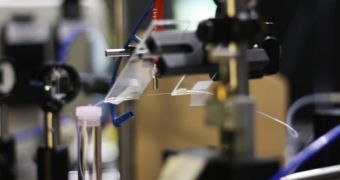Investigators at the University of Michigan say that that using liquid lasers could contribute extensively to discovering slight genetic mutations as they are just starting to cause effects in the body. This could be of tremendous use for the early detection of numerous diseases, including cancer.
In a paper published in the latest issue of the esteemed German journal Angewandte Chemie, the team explains that the approach is used to detect predispositions that certain people may display towards developing various conditions.
Experts have known for a long time that genetic mutations can be indicative of people's disease risks, but thus far methods of accurately identifying the gene variants early on have been largely lacking. With the new discovery, personalized medicine could finally become a reality.
The goal for doctors is to be able to prescribe custom treatments to each individual patient, based on the particularities of their conditions. In order for that to be possible, the experts need access to the full plethora of their patients' genetic information and predispositions.
The current approach to discovering mutated DNA revolves around “patrol molecules” scanning DNA, and binding to mutated strands. Once they are hooked, they become fluorescent, indicating that a problem exists. The issue with this approach is that it's not very effective.
The biomarkers are also in the habit of hooking up with healthy DNA strands, therefore producing a sort of background glow that can obscure the real signal. In the new method, the actual signal is many times brighter than the background.
“We found a clever way to amplify the intrinsic difference in the signals,” explains the principal investigator in the new study, U-M Department of Biomedical Engineering associate professor Xudong Fan.
The secret lies in amplifying light emitted from a laser by passing it through a dye, rather than a crystal. The glass capillary in which the dye rests is called a ring resonator cavity. The paper detailing the device is entitled “Distinguishing DNA by Analog-to-Digital-like Conversion by Using Optofluidic Lasers.”

 14 DAY TRIAL //
14 DAY TRIAL //